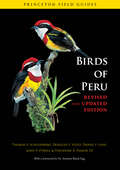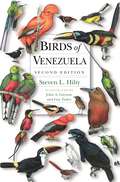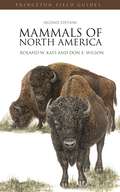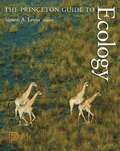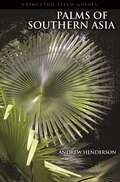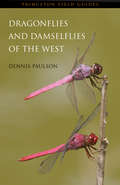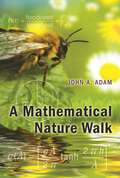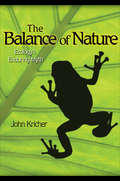- Table View
- List View
Plows, Plagues, and Petroleum: How Humans Took Control of Climate
by William F. RuddimanThe impact on climate from 200 years of industrial development is an everyday fact of life, but did humankind's active involvement in climate change really begin with the industrial revolution, as commonly believed? Plows, Plagues, and Petroleum has sparked lively scientific debate since it was first published--arguing that humans have actually been changing the climate for some 8,000 years--as a result of the earlier discovery of agriculture.The "Ruddiman Hypothesis" will spark intense debate. We learn that the impact of farming on greenhouse-gas levels, thousands of years before the industrial revolution, kept our planet notably warmer than if natural climate cycles had prevailed--quite possibly forestalling a new ice age.Plows, Plagues, and Petroleum is the first book to trace the full historical sweep of human interaction with Earth's climate. Ruddiman takes us through three broad stages of human history: when nature was in control; when humans began to take control, discovering agriculture and affecting climate through carbon dioxide and methane emissions; and, finally, the more recent human impact on climate change. Along the way he raises the fascinating possibility that plagues, by depleting human populations, also affected reforestation and thus climate--as suggested by dips in greenhouse gases when major pandemics have occurred. While our massive usage of fossil fuels has certainly contributed to modern climate change, Ruddiman shows that industrial growth is only part of the picture. The book concludes by looking to the future and critiquing the impact of special interest money on the global warming debate. In the afterword, Ruddiman explores the main challenges posed to his hypothesis, and shows how recent investigations and findings ultimately strengthen the book's original claims.
Birds of Peru: Revised and Updated Edition (PDF)
by Antonio Brack Egg Thomas S. Schulenberg Douglas F. Stotz Daniel F. Lane John P. O'Neill Theodore A. Parker IIIBirds of Peru is the most complete and authoritative field guide to this diverse, neotropical landscape. It features every one of Peru's 1,817 bird species and shows the distinct plumages of each in 307 superb, high-quality color plates. Concise descriptions and color distribution maps are located opposite the plates, making this book much easier to use in the field than standard neotropical field guides. This fully revised paperback edition includes twenty-five additional species. A comprehensive guide to all 1,817 species found in Peru--one fifth of the world's birds--with subspecies, sexes, age classes, and morphs fully illustrated Designed especially for field use, with vivid descriptive information and helpful identification tips opposite color plates Detailed species accounts, including a full-color distribution map Includes 25 additional species not covered in the first edition Features 3 entirely new plates and more than 25 additional illustrations
Birds of Peru: Revised and Updated Edition
by Thomas S. Schulenberg Douglas F. Stotz Daniel F. Lane John P. O'Neill Theodore A. Parker III Dr Antonio Brack EggBirds of Peru is the most complete and authoritative field guide to this diverse, neotropical landscape. It features every one of Peru's 1,817 bird species and shows the distinct plumages of each in 307 superb, high-quality color plates. Concise descriptions and color distribution maps are located opposite the plates, making this book much easier to use in the field than standard neotropical field guides. This fully revised paperback edition includes twenty-five additional species. A comprehensive guide to all 1,817 species found in Peru--one fifth of the world's birds--with subspecies, sexes, age classes, and morphs fully illustrated Designed especially for field use, with vivid descriptive information and helpful identification tips opposite color plates Detailed species accounts, including a full-color distribution map Includes 25 additional species not covered in the first edition Features 3 entirely new plates and more than 25 additional illustrations
Resolving Ecosystem Complexity (MPB-47)
by Oswald J. SchmitzAn ecosystem's complexity develops from the vast numbers of species interacting in ecological communities. The nature of these interactions, in turn, depends on environmental context. How do these components together influence an ecosystem's behavior as a whole? Can ecologists resolve an ecosystem's complexity in order to predict its response to disturbances? Resolving Ecosystem Complexity develops a framework for anticipating the ways environmental context determines the functioning of ecosystems. Oswald Schmitz addresses the critical questions of contemporary ecology: How should an ecosystem be conceptualized to blend its biotic and biophysical components? How should evolutionary ecological principles be used to derive an operational understanding of complex, adaptive ecosystems? How should the relationship between the functional biotic diversity of ecosystems and their properties be understood? Schmitz begins with the universal concept that ecosystems are comprised of species that consume resources and which are then resources for other consumers. From this, he deduces a fundamental rule or evolutionary ecological mechanism for explaining context dependency: individuals within a species trade off foraging gains against the risk of being consumed by predators. Through empirical examples, Schmitz illustrates how species use evolutionary ecological strategies to negotiate a predator-eat-predator world, and he suggests that the implications of species trade-offs are critical to making ecology a predictive science. Bridging the traditional divides between individuals, populations, and communities in ecology, Resolving Ecosystem Complexity builds a systematic foundation for thinking about natural systems.
Resolving Ecosystem Complexity (MPB-47)
by Oswald J. SchmitzAn ecosystem's complexity develops from the vast numbers of species interacting in ecological communities. The nature of these interactions, in turn, depends on environmental context. How do these components together influence an ecosystem's behavior as a whole? Can ecologists resolve an ecosystem's complexity in order to predict its response to disturbances? Resolving Ecosystem Complexity develops a framework for anticipating the ways environmental context determines the functioning of ecosystems. Oswald Schmitz addresses the critical questions of contemporary ecology: How should an ecosystem be conceptualized to blend its biotic and biophysical components? How should evolutionary ecological principles be used to derive an operational understanding of complex, adaptive ecosystems? How should the relationship between the functional biotic diversity of ecosystems and their properties be understood? Schmitz begins with the universal concept that ecosystems are comprised of species that consume resources and which are then resources for other consumers. From this, he deduces a fundamental rule or evolutionary ecological mechanism for explaining context dependency: individuals within a species trade off foraging gains against the risk of being consumed by predators. Through empirical examples, Schmitz illustrates how species use evolutionary ecological strategies to negotiate a predator-eat-predator world, and he suggests that the implications of species trade-offs are critical to making ecology a predictive science. Bridging the traditional divides between individuals, populations, and communities in ecology, Resolving Ecosystem Complexity builds a systematic foundation for thinking about natural systems.
From Populations to Ecosystems: Theoretical Foundations for a New Ecological Synthesis (MPB-46)
by Michel LoreauThe major subdisciplines of ecology--population ecology, community ecology, ecosystem ecology, and evolutionary ecology--have diverged increasingly in recent decades. What is critically needed today is an integrated, real-world approach to ecology that reflects the interdependency of biodiversity and ecosystem functioning. From Populations to Ecosystems proposes an innovative theoretical synthesis that will enable us to advance our fundamental understanding of ecological systems and help us to respond to today's emerging global ecological crisis. Michel Loreau begins by explaining how the principles of population dynamics and ecosystem functioning can be merged. He then addresses key issues in the study of biodiversity and ecosystems, such as functional complementarity, food webs, stability and complexity, material cycling, and metacommunities. Loreau describes the most recent theoretical advances that link the properties of individual populations to the aggregate properties of communities, and the properties of functional groups or trophic levels to the functioning of whole ecosystems, placing special emphasis on the relationship between biodiversity and ecosystem functioning. Finally, he turns his attention to the controversial issue of the evolution of entire ecosystems and their properties, laying the theoretical foundations for a genuine evolutionary ecosystem ecology. From Populations to Ecosystems points the way to a much-needed synthesis in ecology, one that offers a fuller understanding of ecosystem processes in the natural world.
From Populations to Ecosystems: Theoretical Foundations for a New Ecological Synthesis (MPB-46)
by Michel LoreauThe major subdisciplines of ecology--population ecology, community ecology, ecosystem ecology, and evolutionary ecology--have diverged increasingly in recent decades. What is critically needed today is an integrated, real-world approach to ecology that reflects the interdependency of biodiversity and ecosystem functioning. From Populations to Ecosystems proposes an innovative theoretical synthesis that will enable us to advance our fundamental understanding of ecological systems and help us to respond to today's emerging global ecological crisis. Michel Loreau begins by explaining how the principles of population dynamics and ecosystem functioning can be merged. He then addresses key issues in the study of biodiversity and ecosystems, such as functional complementarity, food webs, stability and complexity, material cycling, and metacommunities. Loreau describes the most recent theoretical advances that link the properties of individual populations to the aggregate properties of communities, and the properties of functional groups or trophic levels to the functioning of whole ecosystems, placing special emphasis on the relationship between biodiversity and ecosystem functioning. Finally, he turns his attention to the controversial issue of the evolution of entire ecosystems and their properties, laying the theoretical foundations for a genuine evolutionary ecosystem ecology. From Populations to Ecosystems points the way to a much-needed synthesis in ecology, one that offers a fuller understanding of ecosystem processes in the natural world.
Birds of the Dominican Republic and Haiti (PDF)
by Steven Latta Christopher Rimmer Allan Keith James Wiley Herbert A. Raffaele Kent Mcfarland Eladio FernandezBirds of the Dominican Republic and Haiti fills a large void in the literature on birdwatching and the environment in these tropical countries. The first comprehensive field guide devoted to Hispaniola's birds, it provides detailed accounts for more than 300 species, including thirty-one endemic species. Included in the species descriptions are details on key field marks, similar species, voice, habitats, geographic distribution on Hispaniola, status, nesting, range, and local names used in both the Dominican Republic and Haiti. The authors also comment on ecology, behavior, and taxonomic status. The book provides color illustrations and range maps based on the most recent data available. But the authors' intent is to provide more than just a means of identifying birds. The guide also underscores the importance of promoting the conservation of migratory and resident birds, and building support for environmental measures.
Birds of the Dominican Republic and Haiti
by Steven Latta Christopher Rimmer Allan Keith James Wiley Herbert A. Raffaele Kent Mcfarland Eladio FernandezBirds of the Dominican Republic and Haiti fills a large void in the literature on birdwatching and the environment in these tropical countries. The first comprehensive field guide devoted to Hispaniola's birds, it provides detailed accounts for more than 300 species, including thirty-one endemic species. Included in the species descriptions are details on key field marks, similar species, voice, habitats, geographic distribution on Hispaniola, status, nesting, range, and local names used in both the Dominican Republic and Haiti. The authors also comment on ecology, behavior, and taxonomic status. The book provides color illustrations and range maps based on the most recent data available. But the authors' intent is to provide more than just a means of identifying birds. The guide also underscores the importance of promoting the conservation of migratory and resident birds, and building support for environmental measures.
Birds of Venezuela (PDF)
by Steven L. HiltyVenezuela has an immensely rich bird fauna, with 1,381 known species, many of them found nowhere else in the world. This spectacularly illustrated, comprehensive, and up-to-date guide brings together under one cover much of what is known about these species. Its users can identify all the birds in this vast country, from the Caribbean coast in the north to the Amazonian jungles in the south, from the Andes in the west to the Gran Sabana plateau in the east. With a completely new text by Steven Hilty, Birds of Venezuela is a greatly expanded and thoroughly reformatted successor to the pioneering Guide to the Birds of Venezuela (Princeton,1978). It includes sixty-seven beautiful color and black-and-white plates, most by the well-known artists John Gwynne and Guy Tudor, as well as numerous line drawings. The plates and drawings together--almost half of them never before published--depict most of Venezuela's bird species. Introductory chapters cover physical geography, climate, biogeography, vegetation and habitats, conservation, migration, and the history of ornithology in Venezuela. A gallery of forty-four stunning color habitat photos and color habitat and relief maps complete the opening section. Detailed range maps plot collection localities and sight records--a unique feature--for almost all species. Plumage descriptions are provided for each bird, as is extensive information on voice, behavior, and status. More than 800 bibliographic entries accompany the text, making this book an invaluable and broad-based reference to the avifauna of not only Venezuela but much of northern South America. Treating nearly 40 percent of the continent's bird species, Birds of Venezuela is the definitive resource for all birders with an eager eye on this splendorous country and the surrounding region. The most comprehensive, up-to-date, and best illustrated guide to the birds of Venezuela Covers all 1,381 known species and their subspecies from the Caribbean coast to the jungles of the Amazon, from the Andes to the Gran Sabana plateau--nearly 40 percent of all bird species in South America Completely new text accompanied by more than 800 bibliographic entries Strikingly illustrated with 67 color and black & white plates and numerous line drawings 44 stunning color habitat photos and color habitat and relief maps Detailed range maps for each species
Birds of Venezuela
by Steven L. HiltyVenezuela has an immensely rich bird fauna, with 1,381 known species, many of them found nowhere else in the world. This spectacularly illustrated, comprehensive, and up-to-date guide brings together under one cover much of what is known about these species. Its users can identify all the birds in this vast country, from the Caribbean coast in the north to the Amazonian jungles in the south, from the Andes in the west to the Gran Sabana plateau in the east. With a completely new text by Steven Hilty, Birds of Venezuela is a greatly expanded and thoroughly reformatted successor to the pioneering Guide to the Birds of Venezuela (Princeton,1978). It includes sixty-seven beautiful color and black-and-white plates, most by the well-known artists John Gwynne and Guy Tudor, as well as numerous line drawings. The plates and drawings together--almost half of them never before published--depict most of Venezuela's bird species. Introductory chapters cover physical geography, climate, biogeography, vegetation and habitats, conservation, migration, and the history of ornithology in Venezuela. A gallery of forty-four stunning color habitat photos and color habitat and relief maps complete the opening section. Detailed range maps plot collection localities and sight records--a unique feature--for almost all species. Plumage descriptions are provided for each bird, as is extensive information on voice, behavior, and status. More than 800 bibliographic entries accompany the text, making this book an invaluable and broad-based reference to the avifauna of not only Venezuela but much of northern South America. Treating nearly 40 percent of the continent's bird species, Birds of Venezuela is the definitive resource for all birders with an eager eye on this splendorous country and the surrounding region. The most comprehensive, up-to-date, and best illustrated guide to the birds of Venezuela Covers all 1,381 known species and their subspecies from the Caribbean coast to the jungles of the Amazon, from the Andes to the Gran Sabana plateau--nearly 40 percent of all bird species in South America Completely new text accompanied by more than 800 bibliographic entries Strikingly illustrated with 67 color and black & white plates and numerous line drawings 44 stunning color habitat photos and color habitat and relief maps Detailed range maps for each species
Mammals of North America: Second Edition
by Roland W. Kays Don E. WilsonThe best-selling field guide that "sets new standards" (New Scientist) and "makes all other field guides for mammals of the United States. . . and Canada obsolete" (Journal of Mammalogy) is now even better. Covering 20 species recognized since 2002 and including 13 new color plates, this fully revised edition of Mammals of North America illustrates all 462 known mammal species in the United States and Canada--each in beautiful color and accurate detail. With a more up-to-date species list than any other guide, improved facing-page descriptions, easier-to-read distribution maps, updated common and scientific names, and track and scat illustrations, this slim, light, and easy-to-use volume is the must-have source for identifying North American mammals. Roland Kays and Don Wilson have scoured the technical literature to pull out the key differences between similar species, and illustrated these whenever possible, making the guide useful to amateur naturalists and professional zoologists alike. Casual animal watchers will appreciate the overview of mammal diversity and the tips on identifying animals they can spy in their binoculars, while scientists will appreciate the exacting detail needed to distinguish similar species, including illustrations of shrew teeth, bat toes, and whale dorsal fins. The best-illustrated and easiest-to-use field guide to North American mammals Beautiful and accurate color illustrations of all 462 mammals found in the United States and Canada--including 20 species recognized since 2002 112 color plates--including 13 new ones Key identification information--fully revised--on facing pages The most current taxonomy/species list Fully revised, easy-to-read range maps Illustrations of tracks, scat, and whale and dolphin dive sequences
Mammals of North America: Second Edition
by Roland W. Kays Don E. WilsonThe best-selling field guide that "sets new standards" (New Scientist) and "makes all other field guides for mammals of the United States. . . and Canada obsolete" (Journal of Mammalogy) is now even better. Covering 20 species recognized since 2002 and including 13 new color plates, this fully revised edition of Mammals of North America illustrates all 462 known mammal species in the United States and Canada--each in beautiful color and accurate detail. With a more up-to-date species list than any other guide, improved facing-page descriptions, easier-to-read distribution maps, updated common and scientific names, and track and scat illustrations, this slim, light, and easy-to-use volume is the must-have source for identifying North American mammals. Roland Kays and Don Wilson have scoured the technical literature to pull out the key differences between similar species, and illustrated these whenever possible, making the guide useful to amateur naturalists and professional zoologists alike. Casual animal watchers will appreciate the overview of mammal diversity and the tips on identifying animals they can spy in their binoculars, while scientists will appreciate the exacting detail needed to distinguish similar species, including illustrations of shrew teeth, bat toes, and whale dorsal fins. The best-illustrated and easiest-to-use field guide to North American mammals Beautiful and accurate color illustrations of all 462 mammals found in the United States and Canada--including 20 species recognized since 2002 112 color plates--including 13 new ones Key identification information--fully revised--on facing pages The most current taxonomy/species list Fully revised, easy-to-read range maps Illustrations of tracks, scat, and whale and dolphin dive sequences
The Princeton Guide to Ecology
by Simon A. Levin Stephen R. Carpenter H. Charles Godfray Ann P. Kinzig Michel Loreau Jonathan B. Losos Brian Walker David S. WilcoveThe Princeton Guide to Ecology is a concise, authoritative one-volume reference to the field's major subjects and key concepts. Edited by eminent ecologist Simon Levin, with contributions from an international team of leading ecologists, the book contains more than ninety clear, accurate, and up-to-date articles on the most important topics within seven major areas: autecology, population ecology, communities and ecosystems, landscapes and the biosphere, conservation biology, ecosystem services, and biosphere management. Complete with more than 200 illustrations (including sixteen pages in color), a glossary of key terms, a chronology of milestones in the field, suggestions for further reading on each topic, and an index, this is an essential volume for undergraduate and graduate students, research ecologists, scientists in related fields, policymakers, and anyone else with a serious interest in ecology. Explains key topics in one concise and authoritative volume Features more than ninety articles written by an international team of leading ecologists Contains more than 200 illustrations, including sixteen pages in color Includes glossary, chronology, suggestions for further reading, and index Covers autecology, population ecology, communities and ecosystems, landscapes and the biosphere, conservation biology, ecosystem services, and biosphere management
The Princeton Guide to Ecology
by Simon A. Levin Stephen R. Carpenter H. Charles Godfray Ann P. Kinzig Michel Loreau Jonathan B. Losos Brian Walker David S. WilcoveThe Princeton Guide to Ecology is a concise, authoritative one-volume reference to the field's major subjects and key concepts. Edited by eminent ecologist Simon Levin, with contributions from an international team of leading ecologists, the book contains more than ninety clear, accurate, and up-to-date articles on the most important topics within seven major areas: autecology, population ecology, communities and ecosystems, landscapes and the biosphere, conservation biology, ecosystem services, and biosphere management. Complete with more than 200 illustrations (including sixteen pages in color), a glossary of key terms, a chronology of milestones in the field, suggestions for further reading on each topic, and an index, this is an essential volume for undergraduate and graduate students, research ecologists, scientists in related fields, policymakers, and anyone else with a serious interest in ecology. Explains key topics in one concise and authoritative volume Features more than ninety articles written by an international team of leading ecologists Contains more than 200 illustrations, including sixteen pages in color Includes glossary, chronology, suggestions for further reading, and index Covers autecology, population ecology, communities and ecosystems, landscapes and the biosphere, conservation biology, ecosystem services, and biosphere management
Palms of Southern Asia
by Andrew HendersonSouthern Asia is a vast and ecologically diverse region that extends from the deserts of Afghanistan to the rainforests of Thailand, and is home to a marvelously rich palm flora. Palms of Southern Asia is the only complete field guide to the 43 genera and 352 species of palms and rattans that occur in Afghanistan, Bangladesh, Bhutan, Cambodia, China, India, Japan, Laos, Myanmar, Nepal, Pakistan, Sri Lanka, Taiwan, Thailand, and Vietnam. This attractive guide's handsome illustrations and succinct, authoritative, and jargon-free text make identification easy. Each species account includes the correct scientific and common names, and fully describes morphology, habitat, and uses. Featuring a distribution map for most species and 256 full-color photographs, this is also the only field guide to cover the extremely diverse palm flora of Vietnam, and the first to offer a taxonomic overview of the rattan species of Southern Asia. Palms of Southern Asia is a book of major importance for botanists and an invaluable aid for naturalists and conservationists, and it's the perfect field guide for ecotourists traveling in the region. Covers all 352 naturally occurring palms in Southern Asia Features full-color photographs of 256 species, many never before illustrated Includes a distribution map for most species Provides the first taxonomic overview of the rattans of Southern Asia
Palms of Southern Asia
by Andrew HendersonSouthern Asia is a vast and ecologically diverse region that extends from the deserts of Afghanistan to the rainforests of Thailand, and is home to a marvelously rich palm flora. Palms of Southern Asia is the only complete field guide to the 43 genera and 352 species of palms and rattans that occur in Afghanistan, Bangladesh, Bhutan, Cambodia, China, India, Japan, Laos, Myanmar, Nepal, Pakistan, Sri Lanka, Taiwan, Thailand, and Vietnam. This attractive guide's handsome illustrations and succinct, authoritative, and jargon-free text make identification easy. Each species account includes the correct scientific and common names, and fully describes morphology, habitat, and uses. Featuring a distribution map for most species and 256 full-color photographs, this is also the only field guide to cover the extremely diverse palm flora of Vietnam, and the first to offer a taxonomic overview of the rattan species of Southern Asia. Palms of Southern Asia is a book of major importance for botanists and an invaluable aid for naturalists and conservationists, and it's the perfect field guide for ecotourists traveling in the region. Covers all 352 naturally occurring palms in Southern Asia Features full-color photographs of 256 species, many never before illustrated Includes a distribution map for most species Provides the first taxonomic overview of the rattans of Southern Asia
Dragonflies and Damselflies of the West (PDF)
by Dennis PaulsonDragonflies and Damselflies of the West is the first fully illustrated field guide to all 348 species of dragonflies and damselflies in western North America. Dragonflies and damselflies are large, stunningly beautiful insects, as readily observable as birds and butterflies. This unique guide makes identifying them easy--its compact size and user-friendly design make it the only guide you need in the field. Every species is generously illustrated with full-color photographs and a distribution map, and structural features are illustrated where they aid in-hand identification. Detailed species accounts include information on size, distribution, flight season, similar species, habitat, and natural history. Dennis Paulson's introduction provides an essential primer on the biology, natural history, and conservation of these important and fascinating insects, along with helpful tips on how to observe and photograph them. Dragonflies and Damselflies of the West is the field guide naturalists, conservationists, and dragonfly enthusiasts have been waiting for. Covers all 348 western species in detail Features a wealth of color photographs Provides a color distribution map for every species Includes helpful identification tips Serves as an essential introduction to dragonflies and their natural history
Dragonflies and Damselflies of the West
by Dennis PaulsonDragonflies and Damselflies of the West is the first fully illustrated field guide to all 348 species of dragonflies and damselflies in western North America. Dragonflies and damselflies are large, stunningly beautiful insects, as readily observable as birds and butterflies. This unique guide makes identifying them easy--its compact size and user-friendly design make it the only guide you need in the field. Every species is generously illustrated with full-color photographs and a distribution map, and structural features are illustrated where they aid in-hand identification. Detailed species accounts include information on size, distribution, flight season, similar species, habitat, and natural history. Dennis Paulson's introduction provides an essential primer on the biology, natural history, and conservation of these important and fascinating insects, along with helpful tips on how to observe and photograph them. Dragonflies and Damselflies of the West is the field guide naturalists, conservationists, and dragonfly enthusiasts have been waiting for. Covers all 348 western species in detail Features a wealth of color photographs Provides a color distribution map for every species Includes helpful identification tips Serves as an essential introduction to dragonflies and their natural history
A Mathematical Nature Walk (PDF)
by John A. AdamHow heavy is that cloud? Why can you see farther in rain than in fog? Why are the droplets on that spider web spaced apart so evenly? If you have ever asked questions like these while outdoors, and wondered how you might figure out the answers, this is a book for you. An entertaining and informative collection of fascinating puzzles from the natural world around us, A Mathematical Nature Walk will delight anyone who loves nature or math or both. John Adam presents ninety-six questions about many common natural phenomena--and a few uncommon ones--and then shows how to answer them using mostly basic mathematics. Can you weigh a pumpkin just by carefully looking at it? Why can you see farther in rain than in fog? What causes the variations in the colors of butterfly wings, bird feathers, and oil slicks? And why are large haystacks prone to spontaneous combustion? These are just a few of the questions you'll find inside. Many of the problems are illustrated with photos and drawings, and the book also has answers, a glossary of terms, and a list of some of the patterns found in nature. About a quarter of the questions can be answered with arithmetic, and many of the rest require only precalculus. But regardless of math background, readers will learn from the informal descriptions of the problems and gain a new appreciation of the beauty of nature and the mathematics that lies behind it.
A Mathematical Nature Walk
by John A. AdamHow heavy is that cloud? Why can you see farther in rain than in fog? Why are the droplets on that spider web spaced apart so evenly? If you have ever asked questions like these while outdoors, and wondered how you might figure out the answers, this is a book for you. An entertaining and informative collection of fascinating puzzles from the natural world around us, A Mathematical Nature Walk will delight anyone who loves nature or math or both. John Adam presents ninety-six questions about many common natural phenomena--and a few uncommon ones--and then shows how to answer them using mostly basic mathematics. Can you weigh a pumpkin just by carefully looking at it? Why can you see farther in rain than in fog? What causes the variations in the colors of butterfly wings, bird feathers, and oil slicks? And why are large haystacks prone to spontaneous combustion? These are just a few of the questions you'll find inside. Many of the problems are illustrated with photos and drawings, and the book also has answers, a glossary of terms, and a list of some of the patterns found in nature. About a quarter of the questions can be answered with arithmetic, and many of the rest require only precalculus. But regardless of math background, readers will learn from the informal descriptions of the problems and gain a new appreciation of the beauty of nature and the mathematics that lies behind it.
Friction: An Ethnography of Global Connection
by Anna Lowenhaupt TsingA wheel turns because of its encounter with the surface of the road; spinning in the air it goes nowhere. Rubbing two sticks together produces heat and light; one stick alone is just a stick. In both cases, it is friction that produces movement, action, effect. Challenging the widespread view that globalization invariably signifies a "clash" of cultures, anthropologist Anna Tsing here develops friction in its place as a metaphor for the diverse and conflicting social interactions that make up our contemporary world. She focuses on one particular "zone of awkward engagement"--the rainforests of Indonesia--where in the 1980s and the 1990s capitalist interests increasingly reshaped the landscape not so much through corporate design as through awkward chains of legal and illegal entrepreneurs that wrested the land from previous claimants, creating resources for distant markets. In response, environmental movements arose to defend the rainforests and the communities of people who live in them. Not confined to a village, a province, or a nation, the social drama of the Indonesian rainforest includes local and national environmentalists, international science, North American investors, advocates for Brazilian rubber tappers, UN funding agencies, mountaineers, village elders, and urban students, among others--all combining in unpredictable, messy misunderstandings, but misunderstandings that sometimes work out. Providing a portfolio of methods to study global interconnections, Tsing shows how curious and creative cultural differences are in the grip of worldly encounter, and how much is overlooked in contemporary theories of the global.
Friction: An Ethnography of Global Connection
by Anna Lowenhaupt TsingA wheel turns because of its encounter with the surface of the road; spinning in the air it goes nowhere. Rubbing two sticks together produces heat and light; one stick alone is just a stick. In both cases, it is friction that produces movement, action, effect. Challenging the widespread view that globalization invariably signifies a "clash" of cultures, anthropologist Anna Tsing here develops friction in its place as a metaphor for the diverse and conflicting social interactions that make up our contemporary world. She focuses on one particular "zone of awkward engagement"--the rainforests of Indonesia--where in the 1980s and the 1990s capitalist interests increasingly reshaped the landscape not so much through corporate design as through awkward chains of legal and illegal entrepreneurs that wrested the land from previous claimants, creating resources for distant markets. In response, environmental movements arose to defend the rainforests and the communities of people who live in them. Not confined to a village, a province, or a nation, the social drama of the Indonesian rainforest includes local and national environmentalists, international science, North American investors, advocates for Brazilian rubber tappers, UN funding agencies, mountaineers, village elders, and urban students, among others--all combining in unpredictable, messy misunderstandings, but misunderstandings that sometimes work out. Providing a portfolio of methods to study global interconnections, Tsing shows how curious and creative cultural differences are in the grip of worldly encounter, and how much is overlooked in contemporary theories of the global.
The Balance of Nature: Ecology's Enduring Myth
by John KricherThe idea of a balance of nature has been a dominant part of Western philosophy since before Aristotle, and it persists in the public imagination and even among some ecologists today. In this lively and thought-provoking book, John Kricher demonstrates that nature in fact is not in balance, nor has it ever been at any stage in Earth's history. He explains how and why this notion of a natural world in balance has endured for so long, and he shows why, in these times of extraordinary human influence on the planet's ecosystems, it is critical that we accept and understand that evolution is a fact of life, and that ecology is far more dynamic than we ever imagined. The Balance of Nature traces the fascinating history of the science of ecology and evolutionary biology, from the discipline's early innovators to the advent of Darwin and evolution, to the brilliant and inquisitive scientific minds of today. Blending insights and entertaining stories from his own remarkable life in science, Kricher reveals how evolution is a powerful engine that drives ecological change, how nature is constantly in flux and, in effect, quite naturally out of balance--and how notions to the contrary are misguided and ultimately hazardous to us all. The Balance of Nature forcefully argues that an understanding of the dynamic nature of ecology and evolution is essential to formulating policies of environmental ethics to guide humanity toward a more responsible stewardship of our planet's ecosystems.
The Medea Hypothesis: Is Life on Earth Ultimately Self-Destructive?
by Peter WardIn The Medea Hypothesis, renowned paleontologist Peter Ward proposes a revolutionary and provocative vision of life's relationship with the Earth's biosphere--one that has frightening implications for our future, yet also offers hope. Using the latest discoveries from the geological record, he argues that life might be its own worst enemy. This stands in stark contrast to James Lovelock's Gaia hypothesis--the idea that life sustains habitable conditions on Earth. In answer to Gaia, which draws on the idea of the "good mother" who nurtures life, Ward invokes Medea, the mythical mother who killed her own children. Could life by its very nature threaten its own existence? According to the Medea hypothesis, it does. Ward demonstrates that all but one of the mass extinctions that have struck Earth were caused by life itself. He looks at our planet's history in a new way, revealing an Earth that is witnessing an alarming decline of diversity and biomass--a decline brought on by life's own "biocidal" tendencies. And the Medea hypothesis applies not just to our planet--its dire prognosis extends to all potential life in the universe. Yet life on Earth doesn't have to be lethal. Ward shows why, but warns that our time is running out. Breathtaking in scope, The Medea Hypothesis is certain to arouse fierce debate and radically transform our worldview. It serves as an urgent challenge to all of us to think in new ways if we hope to save ourselves from ourselves.

